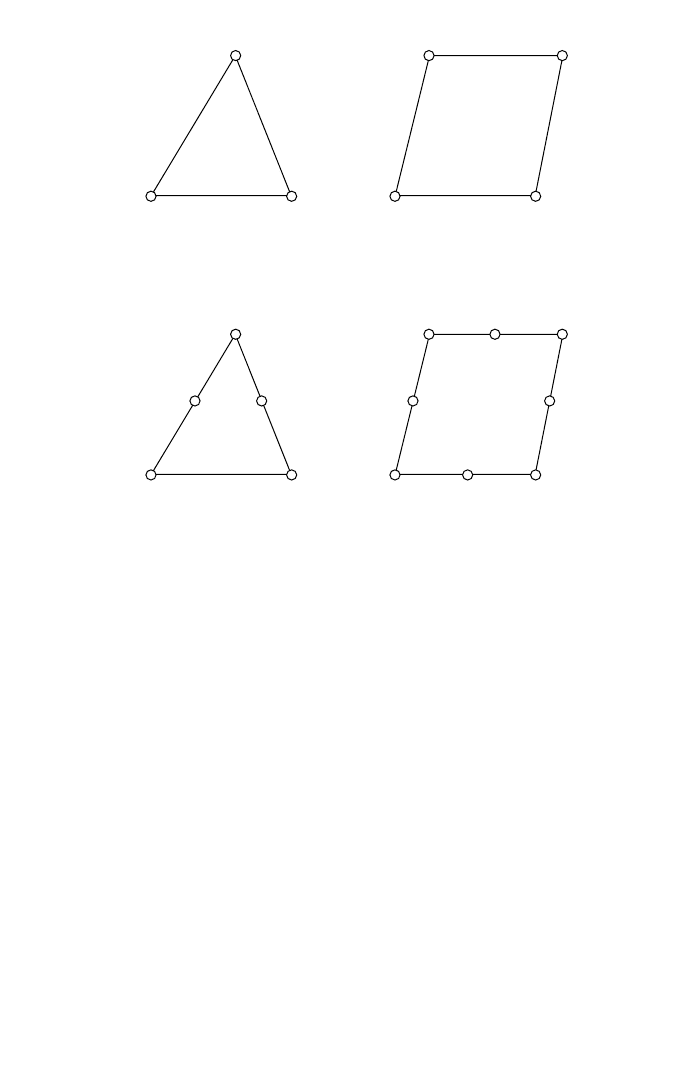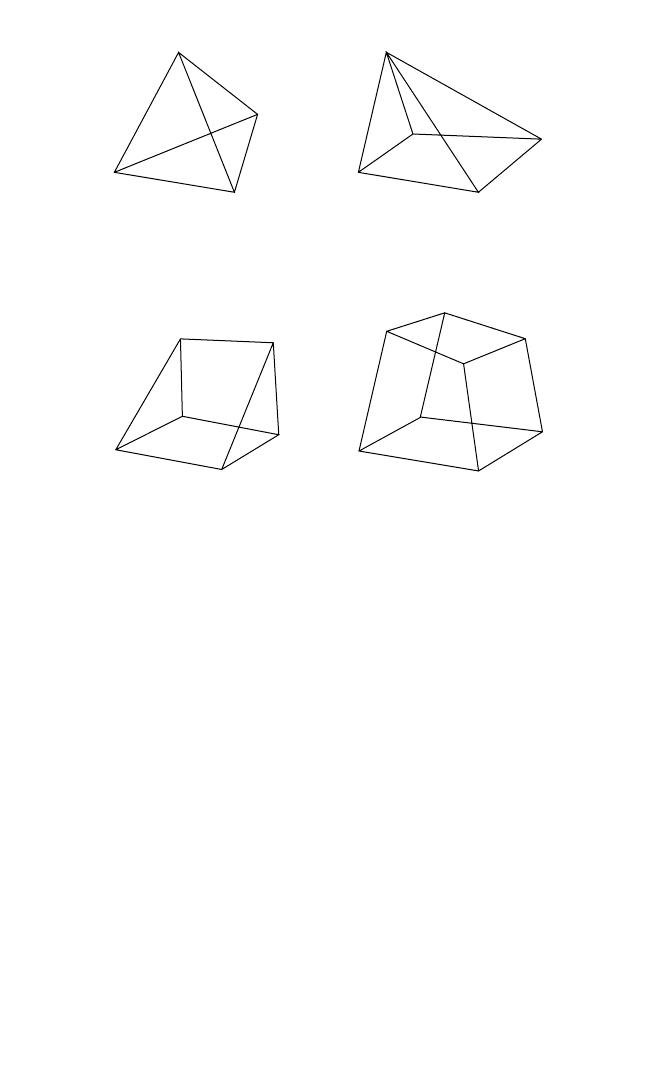Harris C.M., Piersol A.G. Harris Shock and vibration handbook
Подождите немного. Документ загружается.


CHAPTER 28, PART II
FINITE ELEMENT MODELS
Robert N. Coppolino
INTRODUCTION
The finite element method (FEM), formally introduced by Clough
1
in 1960, has
become a mature engineering discipline during the past forty years. In actual prac-
tice, finite element analysis is a systematic applied science, which incorporates (1)
the definition of a physical model of a complex system as a collection of building
blocks (finite elements), (2) the solution of matrix equations describing the physical
model, and (3) the analysis and interpretation of numerical results. The foundations
of finite element analysis are (a) the design of consistent, robust finite elements
2
; and
(b) matrix methods of numerical analysis
3,4,5
(see Chap. 28, Part I). Originally devel-
oped to address modeling and analysis of complex structures, the finite element
approach is now applied to a wide variety of engineering applications including heat
transfer, fluid dynamics, and electromagnetics, as well as multiphysics (coupled
interaction) applications.
Modern finite element programs include powerful graphical user interface
(GUI) driven preprocessors and postprocessors, which automate routine operations
required for the definition of models and the interpretation of numerical results,
respectively (see Chap. 27). Moreover, finite element analysis, computer-assisted
design and optimization, and laboratory/field testing are viewed as an integrated
“concurrent engineering” process. Commercially available products, widely used in
industry, include MSC/NASTRAN (a product of MSC.Software), ANSYS (a prod-
uct family of ANSYS Incorporated), and ABAQUS (a product of HKS Incorpo-
rated), just to mention a few.
This chapter describes finite element modeling and analysis with an emphasis on
its application to the shock and vibration of structures and structures interacting
with fluid media. Included are discussions on the theoretical foundations of finite
element models, effective modeling guidelines, dynamic system models and analysis
strategies, and common industry practice.
THEORETICAL FOUNDATIONS OF FINITE
ELEMENT MODELS
APPLICATION OF MINIMAL PRINCIPLES
The matrix equations describing both individual finite elements and complete finite
element system models are defined on the basis of minimal principles. In particular,
28.29
8434_Harris_28_b.qxd 09/20/2001 11:48 AM Page 28.29

for structural dynamic systems, Hamilton’s Principle or Lagrange’s Equations
6
con-
stitute the underlying physical principle. The fundamental statement of Hamilton’s
Principle is
δ
t
1
t
0
(T + W)dt = 0 (28.44)
where T is the system kinetic energy, W is the work performed by internal and
external forces, t represents time, and δ is the variational operator. In the case of
statics, Hamilton’s Principle reduces to the Principle of Virtual Work, stated mathe-
matically as
δW = 0 (if T = 0) (28.45)
For most mechanical systems of interest, W may be expressed in terms of a conser-
vative interior elastic potential energy (U), dissipative interior work (W
D
), and the
work associated with externally applied forces (W
E
). Thus Hamilton’s Principle is
stated as
t
1
t
0
(δT −δU +δW
D
+δW
E
)dt = 0 (28.46)
The kinematics of a mechanical system of volume, V, are described in terms of the
displacement field
{u} = [N
u
N
q
]
(28.47)
where {u} is the displacement array at any point in V, {u
i
} is an array of discrete dis-
placements (typically) on the element surface, and {q} is an array of generalized dis-
placement coefficients. The transformation matrix partitions, N
u
and N
q
, describe
assumed shape functions for the particular finite element. The most commonly used
elements, namely H-type elements, do not include generalized displacement coeffi-
cients, {q}. The more general case element is called a P-type element. For simplicity,
the subsequent discussion will be limited to H-type elements.
In matrix notation (see Chap. 28, Part I), the strain field within the element vol-
ume is related to the assumed displacements by the differential operator matrix
[N
εu
] as
{ε(x,y,z,t)} = {ε} = [N
εu
]{u} (28.48)
The stress field within the element volume is expressed as
{σ(x,y,z,t)} = {σ} = [D]{ε} = [D][N
εu
]{u} (28.49)
In the case of hybrid finite element formulations, for which there is an assumed ele-
ment stress field other than simply [D][N
εu
], the situation is more involved.
Using the above general expressions, the kinetic and strain energies associated
with a finite element are
u
i
q
28.30 CHAPTER TWENTY-EIGHT, PART II
8434_Harris_28_b.qxd 09/20/2001 11:48 AM Page 28.30

2T =
v
{
u}
T
[N
u
]
T
[ρ][N
u
]{
u}dV = {
u}
T
[M
e
]{
u} (28.50)
2U =
v
{u}
T
[N
εu
]
T
[D][N
εu
]{u}dV = {u}
T
[K
e
]{u} (28.51)
where [ρ] is the material density matrix, [D] is the material elastic matrix, and [M
e
]
and [K
e
] are the individual element mass and stiffness matrices, respectively. The
superscript shown as { }
T
and [ ]
T
denotes the transpose of an array and matrix,
respectively. In the case of viscous damping (which is a common yet not necessarily
realistic assumption), the element virtual dissipative work is
δW
D
= {δu}
T
[B
e
]{
u} (28.52)
where [B
e
] is the symmetric element damping matrix.
In order to assemble the mass, stiffness, and damping matrices associated with a
complete finite element system model, the displacement array for the entire system,
{u
g
}, must first be defined. The individual element contributions to the system are
then allocated (and accumulated) to the appropriate rows and columns of the sys-
tem matrices. This results in the formation of generally sparse, symmetric matrices.
The complete system kinetic and strain energies are, respectively,
2T
g
= {
u
g
}
T
[M
gg
]{
u
g
} (28.53)
2U
g
= {u
g
}
T
[K
gg
]{u
g
} (28.54)
where [M
gg
] and [K
gg
] are the system mass and stiffness matrices.
For the case of viscous damping, the complete system virtual dissipative work is
δW
Dg
= {δu
g
}
T
[B
gg
]{
u
g
} (28.55)
Finally, the virtual work associated with externally applied forces on the complete
system is defined as
δW
Eg
= {δu
g
}
T
[Γ
ge
]{F
e
} (28.56)
where [Γ
ge
] represents the allocation matrix for externally applied forces, {F
e
},
including moments, stresses, and pressures if applicable. Substitution of the above
expressions for the complete system energies and virtual work into Hamilton’s Prin-
ciple, followed by key manipulations, results in the finite element system differential
equations
[M
gg
]{ü
g
} + [B
gg
]{
u
g
} + [K
gg
]{u
g
} = [Γ
ge
]{F
e
} (28.57)
The task of defining a finite element model is not yet complete at this point. Con-
straints and boundary conditions, as required, must now be imposed. The logical
sequence of imposed constraint types is (1) multipoint constraints (e.g., geometric
constraints expressed as algebraic relationships) and (2) single-point constraints
FINITE ELEMENT MODELS 28.31
8434_Harris_28_b.qxd 09/20/2001 11:48 AM Page 28.31

(e.g., fixed supports). These constraints are described, in summary, by the linear
transformation
{u
g
} = [G
gf
]{u
f
} (28.58)
where {u
f
} is the array of “free” displacements. By imposing the constraint transfor-
mation, [G
gf
], in a symmetric manner to the system equations [see Eq. (28.57)], the
following constrained system equations are formed:
[M
ff
]{ü
f
} + [B
ff
]{
u
f
} + [K
ff
]{u
f
} = [Γ
fe
]{F
e
} (28.59)
where
[M
ff
] = [G
gf
]
T
[M
gg
][G
gf
], [B
ff
] = [G
gf
]
T
[B
gg
][G
gf
]
(28.60)
[K
ff
] = [G
gf
]
T
[K
gg
][G
gf
], [Γ
fe
] = [G
gf
]
T
[Γ
ge
]
TYPICAL FINITE ELEMENTS
Commonly used finite elements in commercial codes may be divided into two pri-
mary classes, namely, (1) elements based on technical theories, and (2) elements
based on three-dimensional continuum theory. The first class of elements includes
one-dimensional beam elements.Truss and bar elements are special cases of the gen-
eral beam element. A modern beam element permits modeling of the shear defor-
mation and warping associated with general cross-section geometry. Beam elements,
which may describe a straight or curved segment, are typically described in terms of
nodal displacements (three linear and three angular displacements) at the two
extremities as illustrated in Fig. 28.6.
Also within the family of elements based on technical theories are shell elements.
Membrane and flat plate elements are special cases of the general shell element.
Shell elements are typically of triangular or quadrilateral form with straight or
28.32 CHAPTER TWENTY-EIGHT, PART II
Node 2
Node 1
FIGURE 28.6 Typical beam element.
8434_Harris_28_b.qxd 09/20/2001 11:48 AM Page 28.32

curved edges as illustrated in Fig. 28.7. Common H-type shell elements are defined
by nodal displacements (three linear and three angular displacements) at the ele-
ment corners. Shell elements may also be defined in terms of midside nodal dis-
placements. Modern shell elements may include such features as shear deformation,
anisotropic elastic materials, and composite layering.
The family of three-dimensional elastic elements includes tetrahedral, pentahe-
dral, wedge, and hexahedral configurations with straight or curved edges as illus-
trated in Fig. 28.8. H-type continuum elements are defined by nodal displacements
(three linear) at the element corners. Three-dimensional H-type elements may also
be defined in terms of midside nodal displacements.As in the case of shell elements,
anisotropic elastic materials may be employed in element formulations.
Effect of Static Loading—Differential Stiffness. The effective stiffness of struc-
tures subjected to static loads may be increased or decreased. For example, the lat-
eral stiffness of a column subjected to axial compression decreases, becoming
singular if the fundamental buckling load is imposed. In the case of an inflated bal-
loon, the shell-bending stiffness is almost entirely due to significant membrane ten-
sion. In each of these situations, the static load–associated differential stiffness
derives from a finite geometric change. Modern commercial finite element codes
contain the option to include differential stiffness effects in the model definition.
Fluid-Structure Interaction. Linear dynamic models of oscillating (but otherwise
assumed stationary) fluids interacting with elastic structures are employed in vibro-
acoustics, liquid-filled tank vibratory dynamics, and other applications. One popular
approach used to describe the fluid medium employs pressure degrees-of-freedom. On
the basis of complementary energy principles,
7
three-dimensional fluid elements (with
FINITE ELEMENT MODELS 28.33
FIGURE 28.7 Typical triangular and quadrilateral shell elements.
8434_Harris_28_b.qxd 09/20/2001 11:48 AM Page 28.33

the geometric configurations illustrated in Fig. 28.8) are defined. The matrix equations
describing dynamics of such a fluid interacting with an elastic structure are of the form
+
=
(28.61)
where [C] is the fluid compliance matrix, [S] is the fluid susceptance matrix (analo-
gous to the inverse of a mass matrix), and [A] is the fluid-structure interface area
matrix. The matrix partitions [Γ
Q
] and [Γ
F
] are the fluid volumetric source flow {
¨
Q
e
}
and the structural applied load {F
e
} allocation matrices, respectively. The system of
equations is unsymmetric due to the fact that it is based on a blend of standard struc-
tural displacement and complementary fluid pressure variational principles.
A variety of algebraic manipulations are used to cast the hydroelastic equations
in a conventional symmetric form. In many applications involving approximately
incompressible (liquid) fluids, the fluid compliance is ignored. The incompressible
hydroelastic equations (without source flow excitation) may then be cast in the
symmetric form
7
[M + M
f
]{ü} + [K]{u} = [Γ
F
]{F
e
} (28.62)
where the (generally full) fluid mass matrix is
[M
f
] = [A][S]
−1
[A]
T
(28.63)
Specialized constraints are often required to permit the decomposition of the generally
singular fluid susceptance matrix.
7
Moreover, specialized eigenvalue analysis proce-
dures are recommended to efficiently deal with the full fluid mass matrix.
¨
Q
e
F
e
0
Γ
F
Γ
Q
0
P
u
0
K
S
−A
¨
P
ü
A
T
M
C
0
28.34 CHAPTER TWENTY-EIGHT, PART II
FIGURE 28.8 Typical three-dimensional solid elements.
8434_Harris_28_b.qxd 09/20/2001 11:48 AM Page 28.34

For the most general case of a compressible fluid, introduction of the fluid volu-
metric strain variable
{v} = [C]{P} (28.64)
results in the symmetric equation set
+
=
(28.65)
As for the incompressible, symmetric formulation, a specialized efficient eigenvalue
analysis procedure (based on the subspace iteration algorithm
8
) is recommended to
efficiently deal with the full hydroelastic mass matrix.
In situations for which the fluid is a lightweight acoustic gas, a decoupling approx-
imation may provide reasonable, approximate dynamic solutions. The approximation
assumes that the acoustic medium is driven by a much heavier structure, which is
unaffected by fluid interaction. The decoupled approximate dynamic equations are
[M]{ü} + [K]{u} = [Γ
F
]{F
e
} (28.66)
[C]{
¨
P} + [S]{P} =−[A
T
]{ü} + [Γ
Q
]{
¨
Q
e
} (28.67)
Uncoupled modal analyses of the structural and acoustic media are used in the com-
putation of the system dynamic response for this approximate formulation.
General Linear System Dynamic Interaction Considerations. In the previous
discussion on fluid-structure interaction, a variety of algebraic manipulations, which
transform coupled unsymmetric dynamic equations to a conventional symmetric lin-
ear formulation, were described.Transformations resulting in symmetric matrix equa-
tions, however, are not possible in more general situations involving dynamic
interaction.
Linear systems which include complicating effects due to the interaction with
general linear subsystems (e.g., control systems, propulsion systems, and perturbed
steady fluid flow) are generally appended with nonsymmetric matrix dynamic rela-
tionships.The nonconventional linear dynamic formulation incorporates state equa-
tions for the interacting subsystem
[A
i
]{q
i
} − {
q
i
} = [B
i
]{
u} + [K
i
]{u} (28.68)
and the forces of interaction with the structural dynamic system
[Γ
i
]{F
i
} = [Γ
i
][C
i
]{q
i
} (28.69)
where {q
i
} are subsystem state variables, [A
i
] is the subsystem plant matrix, and [B
i
],
[K
i
], and [C
i
] are coupling matrices. The complete dynamic system is described by
the state equations
−
=
{F
e
} (28.70)
−M
−1
Γ
e
0
0
ü
u
q
i
u
u
q
i
M
−1
Γ
i
C
i
0
A
i
−M
−1
K
0
−K
i
−M
−1
B
I
−B
i
¨
Q
e
F
e
0
Γ
F
S
−1
Γ
Q
−AS
−1
Γ
Q
v
u
0
K
C
−1
0
¨v
ü
S
−1
A
T
M + AS
−1
A
T
S
−1
AS
−1
FINITE ELEMENT MODELS 28.35
8434_Harris_28_b.qxd 09/20/2001 11:48 AM Page 28.35

The above state equations are of the class
[A
sys
]{q
sysi
} − {
q
sys
} = [Γ
sysi
]{F
sys
} (28.71)
Nonlinear Dynamic Systems. The most general type of dynamic system includes
nonlinear effects, which may be due to large geometric deformations, nonlinear
material behavior, stick-slip friction, gapping, and other complicating effects (see
Chap. 4). Fortunately, many dynamic systems are approximately linear. A thorough
discussion of nonlinear finite element modeling and analysis techniques is beyond
the scope of the present discussion. However, two particularly useful classes of mod-
els are pointed out herein, namely, (1) linear systems with physically localized non-
linear features, and (2) general nonlinear systems.
A structural dynamic system with physically localized nonlinear features is
described by slightly modified linear matrix equations as
[M]{ü} + [B]{
u} + [K]{u} = [Γ
N
]{F
N
(u
N
,
u
N
)} + [Γ
F
]{F
e
} (28.72)
where [Γ
N
] is the allocation matrix for nonlinear features and {F
N
} are the nonlinear
forces related to local displacements and velocities. The local displacements and
velocities are related to global displacements and velocities as
{u
N
} = [Γ
N
]
T
{u}, {
u
N
} = [Γ
N
]
T
{
u} (28.73)
This type of nonlinear dynamic formulation is useful in that the linear portion of the
system may be efficiently treated with modal analysis procedures, to be discussed
later.
General situations involving extensively distributed nonlinear behavior are
described by equations of the type
{ü} = [M]
−1
{F(u,
u,t)} (28.74)
or
=
(28.75)
Advanced numerical integration procedures are employed to treat general nonlin-
ear dynamic systems. The procedures fall into two distinct classes, namely, (a)
implicit methods,
9
and (b) explicit methods.
4
EFFECTIVE MODELING GUIDELINES
CUT-OFF FREQUENCY AND GRID SPACING
In order to develop a relevant dynamic model, general requirements should be
addressed based on
F(u,
u,t)
u
0
I
M
−1
0
ü
u
28.36 CHAPTER TWENTY-EIGHT, PART II
8434_Harris_28_b.qxd 09/20/2001 11:48 AM Page 28.36

1. Frequency bandwidth 0 < f < f*, and intensity (F*) of anticipated dynamic envi-
ronments.
2. General characteristics of structural or mechanical components.
Typical dynamic environments are summarized in Table 28.1. Dynamic environ-
ments are generally (a) harmonic, (b) transient, (c) impulsive, or (d) random. For all
categories, the cut-off frequency (f*) is reliably determined by shock response spec-
trum analysis (see Chap. 23). The overall intensity level of a dynamic environment is
described by a peak amplitude for harmonic, transient, and impulsive events, or by a
statistical amplitude (e.g., mean plus a multiple of the standard deviation) for a long-
duration random environment (see Chaps. 11 and 22). With the cut-off frequency
(f*) established, the shortest relevant wavelength of a forced vibration for compo-
nents in a structural assembly may be calculated. For finite element modeling, the
quarter wavelength (L/4) is of particular interest, since it defines the grid spacing
requirement needed to accurately model the dynamics. The guidelines for typical
structural components are summarized in Table 28.2.
In addition to the above grid spacing guidelines, the engineer must also consider
the limitations associated with beam and plate theories. In particular, if the wave-
length-to-thickness ratio (L/h) is less than about 10, a higher-order theory or 3D
elasticity modeling should be considered. Moreover, modeling requirements for the
capture of stress concentration details may call for a finer grid meshing than sug-
gested by the cut-off frequency. Finally, if the dynamic environment is sufficiently
high in amplitude, nonlinear modeling may be required, e.g., if plate deflections are
greater than the thickness, h.
MODAL DENSITY AND EFFECTIVENESS
OF FINITE ELEMENT MODELS
Finite element modeling is an effective approach for the study of structural and
mechanical system dynamics as long as individual vibration modes have sufficient fre-
quency spacing or low modal density. Modal density is typically described as the num-
ber of modes within a
1
⁄3 octave frequency band (f
0
< f < 1.26 f
0
).When the modal density
of a structural component or structural assembly is greater than 10 modes per
1
⁄3 octave
band, details of individual vibration modes are not of significance and statistical vibra-
tion response characteristics are of primary importance. In such a situation, the Statis-
tical Energy Analysis (SEA) method
10
applies (see Chap. 11). Formulas for modal
density
10
as a mathematical derivative, dn/dω (n = number of modes, ω=frequency in
radians/sec), for typical structural components are summarized in Table 28.3.
FINITE ELEMENT MODELS 28.37
TABLE 28.1 Summary of Typical Dynamic Environments
Environment Chapter or reference
Seismic excitation Chap. 24
Fluid flow Chap. 29, Part I
Wind loads Chap. 29, Part II
Sound Chap. 29, Part III
Transportation and handling impact MIL-STD-810E
Transportation and handling vibration MIL-STD-810E
Shipboard vibration MIL-STD-167-1
8434_Harris_28_b.qxd 09/20/2001 11:48 AM Page 28.37

DYNAMIC SYSTEM MODELS
AND ANALYSIS STRATEGIES
FUNDAMENTAL DYNAMIC FORMULATIONS
finite element dynamic models fall into a variety of classes, which are expressed by
the following general equation sets:
1. Linear structural dynamic systems [see Eq. (28.59)]
2. Linear structural dynamic systems interacting with other media [see Eq. (28.70)]
3. Dynamic systems with localized nonlinear features [see Eqs. (28.72) and (28.73)]
4. Dynamic systems with distributed nonlinear features [see Eqs. (28.74) and
(28.75)]
28.38 CHAPTER TWENTY-EIGHT, PART II
TABLE 28.3 Modal Density for Typical Structural Components
Component Motion Modal density, dn/dω Additional data
String Lateral L/(π/T/ρA
) T = tension, A = area,
ρ=mass density,
L = length
Rod Axial L/(πE/ρ
) E = elastic modulus
Rod Torsion L/(πG/ρ
) G = shear modulus
Beam Bending L/(2π)(ωEI/ρA
)
−1/2
EI = flexural stiffness
Membrane Lateral A
s
ω/(2π)(N/ρh) N = stress resultant,
A
s
= surface area
Plate Bending A
s
/(4π)D/ρh
D = plate flexural stiffness,
h = plate thickness
Acoustic Dilatational V
0
ω
2
/(2π
2
)(B/ρ
)
3
B = bulk modulus,
V
0
= enclosed volume
TABLE 28.2 Guidelines for Dynamic Finite Element Model Meshing
Component Mode type L/4 Additional data
String Lateral (T/ρA
)/4f* T = tension, A = area,
ρ=mass density
Rod Axial (E/ρ
)/4f* E = elastic modulus
Rod Torsion (G/ρ
)/4f* G = shear modulus
Beam Bending (π/2)(EI/ρA)
1/4
/2πf*
EI = flexural stiffness
Membrane Lateral (N/ρh
)/4f* N = stress resultant
Plate Bending (π/2)(D/ρh)
1/4
/2πf*
D = plate flexural stiffness,
h = plate thickness
3D elastic Dilatational (E/ρ
)/4f*
3D elastic Shear (G/ρ
)/4f*
Acoustic Dilatational (B/ρ
)/4f* B = bulk modulus
8434_Harris_28_b.qxd 09/20/2001 11:48 AM Page 28.38
